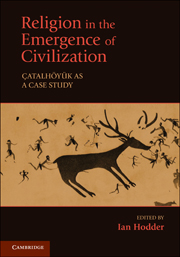Book contents
- Frontmatter
- Contents
- List of Figures and Tables
- Contributors
- 1 Probing religion at Çatalhöyük
- 2 The symbolism of Çatalhöyük in its regional context
- 3 Spiritual entanglement
- 4 Coding the nonvisible
- 5 Modes of religiosity at Çatalhöyük
- 6 Is there religion at Çatalhöyük…or are there just houses?
- 7 History houses
- 8 Marked, absent, habitual
- 9 Temporalities of “religion” at Çatalhöyük
- 10 The Neolithic cosmos of Çatalhöyük
- 11 Magical deposits at Çatalhöyük
- 12 Conclusions and evaluation
- Index
- References
11 - Magical deposits at Çatalhöyük
A matter of time and place?
Published online by Cambridge University Press: 05 June 2012
- Frontmatter
- Contents
- List of Figures and Tables
- Contributors
- 1 Probing religion at Çatalhöyük
- 2 The symbolism of Çatalhöyük in its regional context
- 3 Spiritual entanglement
- 4 Coding the nonvisible
- 5 Modes of religiosity at Çatalhöyük
- 6 Is there religion at Çatalhöyük…or are there just houses?
- 7 History houses
- 8 Marked, absent, habitual
- 9 Temporalities of “religion” at Çatalhöyük
- 10 The Neolithic cosmos of Çatalhöyük
- 11 Magical deposits at Çatalhöyük
- 12 Conclusions and evaluation
- Index
- References
Summary
When is magic? That is, when does an act or thing become magical if it does so at all? Derek Collins (2000) poses this astute question in his recent discussion of Greek magic, and the question seems requisite for any study of magic in the Neolithic as well. Asking when as opposed to what complicates any perfunctory characterization of magic that reinstates simplistic distinctions of symbolic versus pragmatic, ritual versus everyday and natural versus supernatural. Asking when underscores the nuances of context and attributes to prehistoric persons a complex range of motivations, strategies and desires that may have imbued certain moments and activities with a sense of what we might call ‘the magical’. Asking when is infinitely more apt for examining the potential indicators of spirituality at Çatalhöyük, a site where discrete forms of religion and magic remain distinctly beyond archaeological perception. Similarly, it also seems appropriate to ask: where is magic at Çatalhöyük? If practices and things become magical at particular moments, they do so in particular spaces. If there is any ‘evidence’ of magic at Çatalhöyük, it will reveal itself, not as a ready-made or petrified cultural form, but more furtively at specific times and places.
It is impossible to deny that the Neolithic community of Çatalhöyük engaged some kind of concern with a world or force beyond that of the living human population. The plastering, circulation and installation of human and animal skulls, and the depiction of humans and animals in wall painting and modeled media, suggest that certain animals and the dead were likely imbued with some kind of power in the socioreligious sphere. Moreover, the specific and sustained attention given to some houses, which sometimes persisted over several generations, indicates that the house itself played a central role in spiritual life at Çatalhöyük (Hodder 2005b, 2006b). In the past, some have treated the archaeology of certain evocative things – namely, figurines, burials, wall paintings and plastered sculptures – and their interpretation somewhat carelessly, giving them borrowed life through compelling, yet ultimately prefabricated narratives of spirituality, religion and art (Gimbutas 1974; Mellaart 1967). Certainly, this tendency in part reflected the interpretive habits and ideals of those times, but we are now dealing with a remarkably transformed archaeological record and set of standards. Accordingly, not only have the questions concerning religion and spirituality changed, but so also have the ways in which we can investigate them archaeologically.
- Type
- Chapter
- Information
- Religion in the Emergence of CivilizationÇatalhöyük as a Case Study, pp. 300 - 331Publisher: Cambridge University PressPrint publication year: 2010
References
- 11
- Cited by



